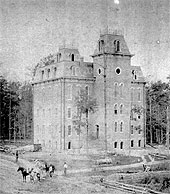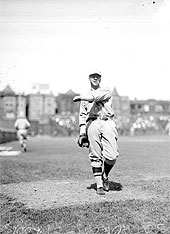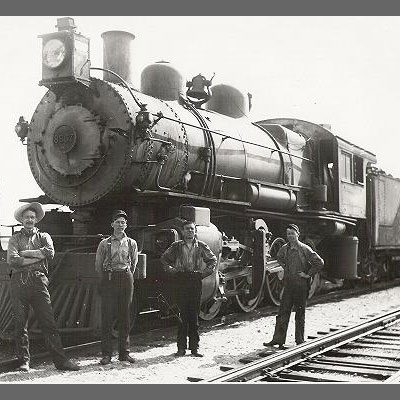
CLICK HERE to download a Word Doc. of the History of Bradford, Ohio.
CLICK HERE for the Bradford Ohio Railroad Museum website
Bradford in the Beginning
 The Village of Bradford, Ohio is situated in both Newberry and Adams Townships of Miami and Darke Counties. Miami County has the greater portion of citizens with the entire population being 1,859 as of the 2000 census. The village dates back to 1857, when the first train reached the end of the railhead at the Miami/Darke County line. At that time this area of Ohio was thick rich forest land with prairies and swamp land sections breaking through the trees. During the early 18th Century this same area had been the hunting grounds for the Shawnee Indians. That all changed in 1795 when the Treaty of Greenville was signed by most of the Ohio Indian tribes and General Anthony Wayne. This opened up huge portions of West Central Ohio for white settlement.
The Village of Bradford, Ohio is situated in both Newberry and Adams Townships of Miami and Darke Counties. Miami County has the greater portion of citizens with the entire population being 1,859 as of the 2000 census. The village dates back to 1857, when the first train reached the end of the railhead at the Miami/Darke County line. At that time this area of Ohio was thick rich forest land with prairies and swamp land sections breaking through the trees. During the early 18th Century this same area had been the hunting grounds for the Shawnee Indians. That all changed in 1795 when the Treaty of Greenville was signed by most of the Ohio Indian tribes and General Anthony Wayne. This opened up huge portions of West Central Ohio for white settlement.
In 1868, the Cincinnati, Columbus & Indiana Central Railroad Company built a roundhouse at the junction of their tracks located in Western Miami County. This was the starting point of the town. The Railroad Company completed twelve stalls of their roundhouse at Bradford, and then increased the number to twenty-four and finally forty-eight stalls for the upkeep of their steam engines.
The town was first called Richmond, Richmond Junction, then Union City Junction, but in 1868, it received the name of Bradford or Bradford Junction from Tom Bradford, a mail agent on the Cincinnati, Columbus & Indiana Central Railroad. He decided the town should be named after him, since there were no other towns in Ohio by that name and he thought Bradford was a good one. The town’s official name today is Bradford Village.
Charles Rapp, who lived on the Miami County side, is considered the town’s first official mail carrier. He was hired by the railroad company to deliver the mail within a designated area around the depot. The depot consisted of an old boxcar. The mail was carried around in Charlie’s pockets and in his hat and delivered as he ran into recipients or visited businesses. Before Mr. Rapp was hired to deliver the mail, area residents would need to travel to Covington or Gettysburg to receive their mail. On March 9, 1901, Bradford established a Rural Free Delivery (RFD) itinerary of mail routes from Bradford as announced by the United States Post Office Department. The new routes covered 50 square miles and served 2,500 people.
 Early in 1868 when the Railroad Company began building in the town, Charles Dearworth built a new boarding house. It was called the “Locust House.” It was located directly across from the depot on the Logansport Division of tracks. It later became known as “Louie’s”. Later on it was operated as “Beardsley’s” and didn’t close until the 1960’s. “Louie’s” still stands on East Main Street as a private residence and faces the old empty track bed.
Early in 1868 when the Railroad Company began building in the town, Charles Dearworth built a new boarding house. It was called the “Locust House.” It was located directly across from the depot on the Logansport Division of tracks. It later became known as “Louie’s”. Later on it was operated as “Beardsley’s” and didn’t close until the 1960’s. “Louie’s” still stands on East Main Street as a private residence and faces the old empty track bed.
At the same time, William Romans, a master mechanic of the Cincinnati, Columbus & Indiana Central Railroad, laid out some lots on the Miami County side.
Dan Rice, a foreman at the roundhouse, also purchased land and charted lots which he sold, these also being in Miami County.
Later on the Railroad Company, Christian Sears, Moses Wise, and Wade Steel laid out more lots. In August 1868, W.H. Sowers built a large warehouse at the junction and engaged in the grain trade using the name J. Sowers & Son. A hotel called The Hoover House was erected and another hotel was built just a little ways east of the Hoover House by Dan Rice and was called the Bradford House. In 1868 one of the first houses to be built in Bradford was put up by John S. Moore. In 1869, J. Sowers & Son engaged in a general merchandise business, in addition to their booming grain trade. Also in 1869, the railway depot was built at the junction. Bradford was really beginning to grow.
Nate Iddings Bradford’s Builder
 In 1870, Nathan Iddings became engaged in the general merchandise business in East Bradford. He was soon forced to give up this endeavor due to sunstroke and set up shop as a general Notary and real estate businessman.
In 1870, Nathan Iddings became engaged in the general merchandise business in East Bradford. He was soon forced to give up this endeavor due to sunstroke and set up shop as a general Notary and real estate businessman.
Nate Iddings alone had more houses erected in Bradford than any other person or business.
He also owned numerous farms around Bradford.
He also served, in an official capacity, as the representative for the Pennsylvania Railroad in dealings with the city.
Bradford was quickly growing and becoming a bustling city full of people.
Bradford Businesses and Schools
 Bradford continued to improve quite rapidly and many houses and stores were being built on both sides of the county line. In 1870, the first schoolhouse was erected, on the Miami County side, which was used until the completion of the Union School building in 1876 on the Darke County side of town. The contractors for the Union School were Dennis Dwyer and George Manix. The cost of the structure was $28,000. It was four stories high including the basement. There was a large school bell and the entire building was heated by steam.
Bradford continued to improve quite rapidly and many houses and stores were being built on both sides of the county line. In 1870, the first schoolhouse was erected, on the Miami County side, which was used until the completion of the Union School building in 1876 on the Darke County side of town. The contractors for the Union School were Dennis Dwyer and George Manix. The cost of the structure was $28,000. It was four stories high including the basement. There was a large school bell and the entire building was heated by steam.
The old school building on Miami Avenue was sold and used as an agricultural store by Henry Klinger and later on it housed Fashner Plumbing. It still stands today just South of Smithfield Street next to The Village Pizza on Miami Avenue.
Bradford children had a great benefactor in a man everyone called “Doc” Wade.
 Aaron L. Wade was one of Bradford’s pioneers and the first jeweler in town. He served in the Civil War and was a member of the GAR (Grand Army of the Republic). Aaron was remembered as a quiet man who was well loved by the children in town. His wife had died at the early age of 28, leaving Aaron with an 8-year-old son named Clement F. Wade. He later died at the young age of 19. The grieving “Doc” Wade directed all of his energies into his businesses and land holdings. He never remarried.
Aaron L. Wade was one of Bradford’s pioneers and the first jeweler in town. He served in the Civil War and was a member of the GAR (Grand Army of the Republic). Aaron was remembered as a quiet man who was well loved by the children in town. His wife had died at the early age of 28, leaving Aaron with an 8-year-old son named Clement F. Wade. He later died at the young age of 19. The grieving “Doc” Wade directed all of his energies into his businesses and land holdings. He never remarried.
During his later years he expressed his love for the children of the community by establishing a special trust for the current and future generations of Bradford’s youngest citizens. He founded the Wade Kindergarten School in Bradford, Ohio in 1923. He established a trust and left a very generous bequest of $8000.00 for the creation and future maintenance of one of Ohio’s first Kindergarten Classes in Bradford. The Trust that Aaron created has served the Bradford Community well over the years and is today still providing partial funding for the current Kindergarten classes and a preschool program.
The Bradford Railway Y.M.C.A.
On October 13, 1905, The Railway Y.M.C.A. was opened. It was built to try to help decrease the fighting, drinking, and gambling that were a big problem at the time. By offering alternative recreation and affordable living quarters for the railroad men, the problems decreased. The Y.M.C.A. became well known up and down the rail line. It was truly considered a home away from home for many railroad workers.
Bradford’s Hometown Hero
 From 1914 to 1927 Bradford had a hometown son, Allen Sutton Sothoron, play Major League Baseball for the Cleveland Indians and the St. Louis Browns.
From 1914 to 1927 Bradford had a hometown son, Allen Sutton Sothoron, play Major League Baseball for the Cleveland Indians and the St. Louis Browns.
He was one of the last legal spitball pitchers to play Major League Baseball. When the spitball was determined to be illegal in 1919, a select few pitchers (17) were allowed to continue the practice as long as they were in a league, and Allen was one of them.
While playing for the Cleveland Indians, in 1921, Sothoron was 12-4 and pitched 178 innings with out giving up one home run.
Allen Sothoron later managed minor league baseball. He also managed the St. Louis Browns briefly in 1933 and coached both St. Louis teams (Browns and Cardinals) until he died June 17, 1939 in St. Louis.
The 1920 Bradford Fire
 On the evening of August 3, 1920 Bradford’s future was drastically changed. About 10:30 PM, two men were hurrying home after working at the local Railway Y.M.C.A. As Johnny Layer and Delmar Faun passed the Arnold Lumber Company on Miami Avenue they caught the strong aroma of coal oil. They then spotted the first flames at the lumberyard. The two men immediately ran to sound the alarm bell for the fire department. By the time the fire department arrived at the scene the flames had grown and turned into a raging, fast moving fire. The railroad had summoned its fire brigade to help with hoses, ladders, and making water available to the city. The fight to kill the growing fire had begun.
On the evening of August 3, 1920 Bradford’s future was drastically changed. About 10:30 PM, two men were hurrying home after working at the local Railway Y.M.C.A. As Johnny Layer and Delmar Faun passed the Arnold Lumber Company on Miami Avenue they caught the strong aroma of coal oil. They then spotted the first flames at the lumberyard. The two men immediately ran to sound the alarm bell for the fire department. By the time the fire department arrived at the scene the flames had grown and turned into a raging, fast moving fire. The railroad had summoned its fire brigade to help with hoses, ladders, and making water available to the city. The fight to kill the growing fire had begun.
At the telephone exchange, across the street from the burning lumber company, an operator by the name of Anna Lehman worked feverishly at the switchboard to summon out of town help. She finally left the building only minutes before the exit was closed off and the building consumed by the now intense fire.
Once the alarm had been sounded and requests for help sent to area fire stations, in little over an hour, fire departments from Versailles, Piqua, and Covington arrived to help. By this time the fire was pure raging destruction. The heat was so intense that it had blistered nearby homes and the Railway Y.M.C.A. Many residents awakened from the noise and commotion.
Seeing the night sky filled with floating, burning embers and realizing the danger to their village and homes, they began helping in the fight to end this tragic nightmare. Other residents became frightened and fearing for their lives grabbed their children, began packing their belongings and left town for safer quarters.
Men were in the streets using anything that would carry water to douse the flames. Panic-stricken merchants were trying to save as much of their goods as they could by dragging them out of the stores and piling them into the dirt streets. When the heat and the flames got closer, the goods would be picked up and moved a little further away. It was to no avail. Before the night was over all the merchandise that had occupied the stores in Bradford’s business district were lost to the flames, smoke, dirt, and water.
Pleas for further assistance and help were being sent out via the railroad. When the telephone exchange burned, wires were melted and all communications with the village were cut off. More help would not arrive till early morning. The water supply was very low and finally gave out. It would become an all night losing battle with severe losses to the community.
The Great Fire, as local residents still call it today, swept through the business district destroying 34 businesses and 12 homes most of which were located in the Iddings block of the village at the corner of Main and Miami Streets. Nate Iddings owned this area of buildings and property. This was the very heart of the Bradford business district. The final estimate of losses totaled to well over $1,000,000.00. Later it was discovered that practically none of the businesses were insured so they could never afford to rebuild what had been lost.
In the next days that followed the news of the devastation and tragedy swept the state and the nation. The fire was the talk of the railroad workers all along the railroad lines both East and West. The tragedy was on everyone’s lips. Bradford, sadly, had made the papers. All were lead stories.
Below is a photo gallery of historic images from Bradford, Ohio. Click on the thumbnails to enlarge.













